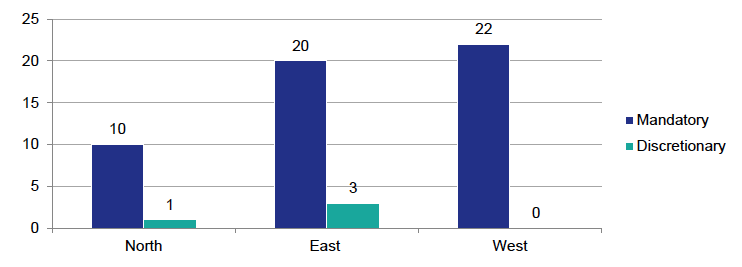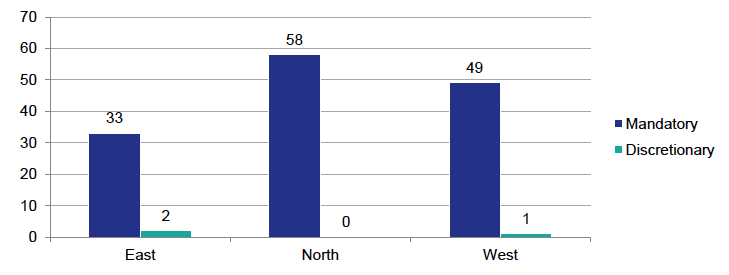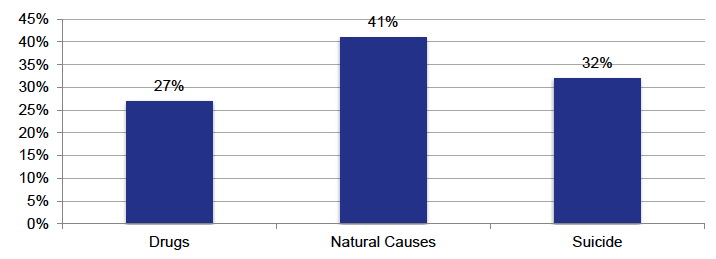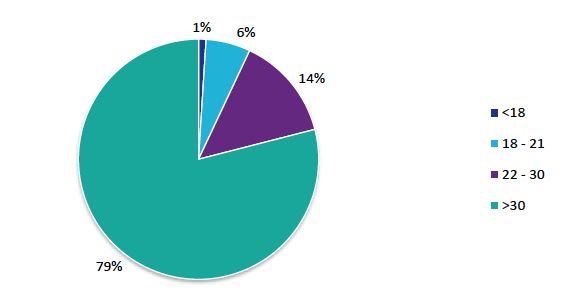Related Downloads
Related Links
Additional
Chapter 3 – Case Review
Cohort
47. There were 131 FAIs concluded between 2016/17 and 2018/19.[37] We examined a statistically significant sample of 56 cases: 52 mandatory FAIs and four discretionary FAIs representing 44% of all mandatory FAIs and 33% of all discretionary FAIs. The sample included 33 mandatory cases relating to deaths while in legal custody and 19 relating to deaths while in employment.
48. Chart 7 provides a breakdown of the cases by type of FAI and SFIU teams.
Chart 7 – FAI Case Review

49. Table 1 illustrates the average number of working days that elapsed between the date of death to the date of the first notice[38] and to the start of the FAI.
Table 1 – Average Number of Working Days
| Date of death to date of First Notice | Date of death to FAI | |
|---|---|---|
| All cases[39] | 434 | 522 |
| All, excluding cases with substantive criminal investigation[40] | 403 | 481 |
| Work-related deaths[41] | 352 | 416 |
| Deaths while in custody[42] | 433 | 519 |
| Discretionary cases[43] | 614 | 763 |
| HSD cases[44] | 488 | 606 |
| Cases with Experts[45] | 631 | 759 |
50. The timeline for concluding cases where there was a substantive criminal investigation prior to holding an FAI tends to be significantly longer than for cases where there is no such consideration. This reflects the tendency of such cases to involve more complex issues and, in some cases, reliance on external reporting agencies. Similar considerations apply to HSD cases. To provide a more representative timeline, we measured the time that elapsed from date of death to the first notice and the start of the FAI, excluding cases with a substantive criminal investigation and HSD cases. We also did a separate timeline for cases progressed solely by HSD and for cases involving expert reports/witnesses.
51. In comparison to the findings in the thematic review, all categories between the date of death to the FAI have decreased although the time between the death and the first notice has increased for both mandatory work-related deaths and deaths in custody.
52. As an organisation that seeks to deliver a sensitive, responsive, and thorough investigation, that meets public expectations, we advocated that COPFS must prioritise the investigation of deaths that may result in criminal proceedings or an FAI. We recommended that:
Recommendation 4
COPFS should introduce an internal target for progressing mandatory FAIs.
Action Taken
Recommendation 4
53. COPFS introduced an internal KPI in September 2018 for all cases requiring further investigation, not concluded within the published target of 12 weeks, to be concluded or, if an FAI is required, to have the first notice lodged within 12 months.
54. The KPI was applied to all existing death investigations, including all mandatory FAIs, resulting in a proportion of cases that were already older than 12 months being included.
Status: Achieved
Compliance with the KPI
Case Review
55. 66% (37) of the 56 cases took longer than 12 months from the date of death to the date of the first notice. This includes 33 mandatory FAIs and all four discretionary FAIs. 12 of the 66% were entirely or partly investigated by HSD.
56. Of the 52 mandatory FAIs, only 37% (19 cases) had a first notice lodged within 12 months.[46]
57. On average the mandatory FAIs took 19.5 months from date of death to lodging the first notice and 23 months to the FAI.
58. On average the discretionary FAIs took two years 11 months from the date of death to the start of the FAI.
59. We examined the cases that took more than 12 months from the date of death to the date of the first notice. The six cases involving a mandatory FAI that had a substantive criminal investigation are discussed in Chapter 4.
Mandatory FAIs
60. We found delays were often due to a combination of factors of which the main contributory reasons were:
- Delays in allocating cases for investigation and/or re-allocating due to staff shortages, workload or staff leaving the team
- Lengthy periods of inactivity
- Delays in obtaining reports, information, documents or statements from reporting agencies and other agencies/investigatory bodies
- Time taken to obtain expert reports
- Late intimation of issues the nearest relatives wanted investigated and/or late involvement of interested parties in the FAI process
61. The contributory factors varied to some extent depending on which SFIU team had ownership of the case.
North Cases
62. Of the seven cases where there was delay:
63. With the exception of two cases, the delay was due to lengthy periods of inactivity. There was evidence that some cases were not progressed due to staff shortages and long term absences with one case only being progressed when it was transferred to the RTFIU. In one case it took ten months to receive the HSE report, although the procurator fiscal had been advised two months after the date of death that the HSE report was in draft form and nothing was done to chase up the report. In the remaining case it took seven months to receive the HSE report and a further seven months for the procurator fiscal to apply for the FAI.
West Cases
64. Of the eight cases where there was delay a more complex picture emerged:
65. In four, there were delays in allocating cases for investigation.
- One was then re-allocated causing significant delay.
66. Other contributory factors causing delays were:
- In two there was lengthy periods of inactivity with no obvious explanation, compounded in one by significant delays in obtaining additional information from the police and in the other by a period of six months to obtain the HSE report and a further period of four months to obtain an expert report.
- In one, although progress was made with the investigation, a late referral to PIRC to investigate one aspect delayed the application for an FAI. There were also a number of preliminary hearings to allow interested parties further time to prepare before the FAI commenced.
67. In two the delay was largely as a result of efforts to engage with nearest relatives and/or other interested parties and to ensure any concerns were investigated prior to the FAI commencing. Additionally, in one expert evidence had to be obtained and a PIRC investigation was also being conducted into associated matters.
68. In one the submission of the HSE report took one year, the procurator fiscal lodged the first notice seven months later and after a further three months the FAI commenced.
69. In one there was a significant period of inactivity following allocation of the case and it took a further five months to receive necessary expert reports.
East Cases
70. Of the twelve cases where there was delay we found:
71. In seven, re-allocation of the cases had fragmented and hampered progress in the investigation causing significant delays. Three had been re-allocated a number of times due to staff leaving the unit. Other contributing factors to delay in the seven cases were:
- In three there were lengthy periods of inactivity with evidence in two that this was due to staff shortages and/or workloads. These delays were also compounded by the time to request and/or receive expert reports, information from the police or other agencies and in one case by late intimation from the nearest relatives that they wanted to be represented at the FAI and were awaiting legal aid.
- In three there were significant delays in the police or other agencies providing additional information, documentation or statements requested. These delays were also compounded in two cases by the time taken to explore and obtain expert reports with evidence that it had not been possible to progress this more quickly due to workload. In the other case there had also been a delay in obtaining court dates for the preliminary hearing and a number of continued preliminary hearings were necessary before the FAI commenced.
- In one it took seven months for the HSE report to be submitted.
72. In two there were lengthy periods of inactivity. In one although there was a delay in the police providing a statement, due to difficulties in tracing a witness, significant time had elapsed between the original request and it being chased up. There was evidence that this had been due to staff shortages in the team.
73. In one the investigation lacked focus and a large amount of time was spent investigating medical matters where no concerns had been raised and with no foundation based on the expert report that had been obtained.
74. In one there were difficulties obtaining a statement from an essential witness and delays due to instructing additional inquiries to address concerns raised by the nearest relatives. A number of preliminary hearings were also necessary before the FAI commenced.
75. In one a delay in the initial allocation of the case followed by a period of inactivity were the main causes of delay compounded by the time taken for the police to provide necessary documentation.
Discretionary FAIs
76. On average the discretionary FAIs took approximately two years and nine months between the date of death to the start of the FAI.
77. There were four discretionary FAIs but one was held for the death of three spectators at the Jim Clark Rally in May 2014 which was conjoined with the death of another spectator that occurred in a motor rally in Skye. Prior to the FAI there had been a thorough investigation to ascertain if criminal proceedings were appropriate. Two expert reports had been obtained by the Crown. Following the decision not to commence criminal proceedings in April 2016, an FAI was instructed in November 2016. While there was a delay in making the application for the FAI, the sheriff highlighted a number of procedural issues that had to be resolved before the FAI could commence, including the fact that until there was a legislative change in 2016, it was not competent for a single sheriff court to deal with deaths which had occurred in different jurisdictions. The legislative change made it possible for the Crown to seek to hold the Inquiry in relation to the deaths occurring in the Highland and Borders regions in a single court. While the two accidents were separate and unconnected, there was the common feature that deaths of spectators had occurred in the course of an organised motor sport event of the same general character. As these events were closely connected in time, and because there had been only two (2006 and 2009) similar events in the recent past anywhere in the UK, it was understandably felt that there was a public interest for there to be formal consideration of issues of safety at motorsport events of that nature.
78. The first notice was lodged in December 2016 and there were a number of continued preliminary hearings before the FAI commenced in July 2017. There were eight interested parties that participated in the inquiry and over 100 witnesses gave evidence. During the inquiry there was an adjournment to allow an expert witness to consider the evidence that had been led. It concluded on 28 September 2017 with the determination being issued on 20 November 2017. It made a number of recommendations designed to improve the safety at such events.
79. The other discretionary inquiry concerned the death of a young man who had, prior to his demise, sought medical assistance and who had discharged himself from a specialist mental health clinic. A period of two years and three months elapsed from the date of death to the commencement of the FAI. SFIU received a psychiatric expert report on the care that the deceased had received at the clinic within six weeks. It was provided to the relevant Health Board for comment, to obtain an update on any actions taken to address any of the concerns raised and for the outcome of their internal review. It took over four months to receive the internal report from the NHS, contributing to the overall delay of 15 months from receipt of the initial expert report to Crown Counsel's final instructions.
80. Discretionary inquiries tend to involve more complex issues, requiring expert reports to be commissioned.
Impact of Delays
81. Lengthy intervals of unexplained delays prior to the start of an FAI adversely impacts on:
- The momentum of investigations and the operational capacity of investigating agencies – investigations characterised by lengthy intervals with intermittent requests for further inquiries to be undertaken run the risk of becoming fragmented and lacking continuity, particularly if the investigators have moved on to new investigations;
- The well-being of potential witnesses for whom the prospect of the inquiry "hanging over them" is a source of anxiety and concern;
- The distress of the nearest relatives;
- Public confidence; and
- The quality of the evidence and delays in implementing any recommendations felt necessary in light of the conclusions of the inquiry and, in some cases, the purpose of the FAI.
82. In contrast to criminal proceedings, there are no statutory legal time limits governing FAIs. In response to calls for time limits to be introduced during the passage of the Fatal Accidents and Sudden Deaths Bill, COPFS gave a commitment to introduce a Family Liaison Charter setting out information to be made available to families and timescales for the giving of information. The Act introduced a requirement for the Lord Advocate to prepare and publish a family liaison charter.[47]
83. While acknowledging that deaths investigations must be thorough, they must also be completed as promptly as possible. While some investigations are complex, often requiring expert evidence, and some involve a criminal investigation making compliance with the KPI difficult, there are many that are relatively straightforward. It is therefore disappointing that more cases in our review did not have a first notice lodged within 12 months.
84. In criminal cases, COPFS must commence a trial within 12 months of an accused person appearing at court and within 140 days if remanded. In the vast majority of cases COPFS investigates and prosecutes such cases within these timescales, including Health and Safety offences, historical institutional sexual crimes, homicides and complex frauds. If such cases can be progressed within these tight timescales, excluding cases where there is an extensive criminal investigation, there is no reason, other than resources as evidenced at paragraphs 63 and 71 above, that FAIs cannot be completed within similar timescales.
Current COPFS FAI Workload
85. There are currently 143 cases where an FAI has been instructed but not concluded.[48] 140 mandatory FAIs; 51% (71) relating to a death while in custody; 49% (69) relating to a death while in employment and three discretionary FAIs.
86. Chart 8 provides a breakdown of current FAIs by type and SFIU team.
Chart 8 – Outstanding FAIs

87. Of the 71 deaths in custody, 65 (92%) occurred in prison and six (8%) in police custody.
88. 68 were male and three were female.
89. Chart 9 provides a breakdown of the recorded cause of the death of those in prison or HMYOI.
Chart 9 – Deaths in Custody[49]

90. Chart 10 provides a breakdown by age of the 71 deaths in custody.
Chart 10 – Age profile of deaths in custody

91. There was one (1%) death of a person aged under 18, four (6%) were aged between 18 and 21, 10 (14%) between 22 and 30 and 56 (79%) were over 30 years of age.
92. Of the 23 suicides in prison, four were under 21 years of age.
Age profile of all outstanding FAIs[50]
93. Currently there are 52% (75) of all outstanding FAIs (143) older than 12 months; 30 are older than a year; 25 are older than two years; eight are older than three years; and 12 are still ongoing after four years.[51] 12 have dates for a preliminary hearing and the FAI.[52]
Chart 11 – Age profile of all outstanding FAIs

94. The age profile of outstanding FAIs remains a concern. Failing to deal with FAIs expeditiously not only impacts on the nearest relatives, it causes distress and concern for potential witnesses including prison and police officers who may have to give evidence at the FAI.
95. Lengthy delays also have the potential to devalue the purpose of the FAI. In many cases, by the time the FAI is held, measures recommended by other inquiries/reviews have been implemented. While it is proper to consider whether any immediate measures are required to prevent deaths in similar circumstances, the FAI is the primary vehicle to examine the circumstances and make recommendations but to do so the timelines require to be significantly improved.
96. Given the greater scrutiny of the circumstances of deaths, the low number of discretionary FAIs is surprising. Discretionary FAIs have historically played an important role in driving up standards of safety in a number of forums, including football matches, medical care and in professions such as diving and dentistry.
Modernisation Project
97. We heard that the failure to progress FAIs is partly due to procurator fiscals having to deal with newly reported deaths while carrying an FAI workload. Inevitably priority is given to dealing with the newly reported deaths; discussing the cause of death with GPs; liaising with nearest relatives and instructing post mortems and other initial inquiries. We were advised that available time to progress FAIs is estimated to be 40% for a full time depute and 20% for a part time depute.
98. The manager of the modernisation project has recently ring-fenced two procurators fiscal in SFIU North to deal solely with some of the older FAIs. This has reaped positive results with an increase in FAIs being concluded. Given the criticism of the lack of progress to deal with FAIs timeously, it is somewhat surprising that a dedicated resource to conduct FAIs has not been introduced earlier. Such an approach mirrors the move towards greater specialisation that COPFS has employed in other areas such as sexual offices, homicides and health and safety cases.
99. We support the move to have a dedicated FAI team to deal with the delays. Procurators fiscal within the team should rotate to maintain expertise on all areas of deaths investigations.
100. As part of the modernisation project work is ongoing to develop an electronic "pathway document" designed to record key milestones and the progress of the case in one place. It also seeks to focus more on obtaining all relevant documentation and statements at an early stage of the investigation and, in particular, to agree a Memorandum of Understanding (MoU) with the Scottish Prison Service (SPS) and National Health Service (NHS) on the type of information that they require to provide as a matter of routine, including medical records, risk assessments etc following any death in custody to expedite the investigation. This would address one of the factors identified as causing delays in our case review.
101. The timetable for the modernisation project has slipped but it is anticipated that most work streams should be completed by the end of this year.
Resourcing
102. In August 2018, COPFS received a significant increase in funding to allow for the recruitment of up to 140 additional permanent members of staff. One of the priorities for the additional resource was to shorten the time taken to conclude deaths investigations. SFIU was allocated a number of additional staff ranging across the grades. While there has been a 23% increase in the staffing complement from April 2018 to April 2019, there is still a shortfall of eight members of staff including four procurators fiscal.[53] When in place the SFIU complement will have increased by 42%. Clearly, it takes time to induct and train new staff and factors such as staff leaving or absences due to maternity leave or illness impact on staff complements but, given the age profile of outstanding FAIs, fulfilling the SFIU complement requires to be addressed as a priority.
